Financial Reporting: Assessing Key Assumptions and Concepts
VerifiedAdded on 2020/10/23
|9
|1779
|172
Report
AI Summary
This report provides a comprehensive analysis of financial reporting, focusing on the assessment of assumptions and concepts under fundamental and qualitative characteristics. It begins with an introduction to financial reporting, emphasizing its role in providing crucial information to stakeholders for informed decision-making. The report then delves into the IASB conceptual framework, highlighting its importance in organizing ideas and making conceptual distinctions. It explores the basic objective of financial reporting, the gap between accounting practices and their underlying rationale, and the various steps involved in the accounting process. The report also discusses the fundamental principles used in measuring financial accounting, including objectivity, matching, revenue recognition, and consistency. Furthermore, it examines the qualitative characteristics of financial information, such as predictive value, confirmatory value, faithful representation, comparability, timeliness, verifiability, and understandability. The second part of the report focuses on the application of assumptions to financial statements, including the economic entity concept, going concern concept, monetary unit concept, periodicity, and accrual basis method. The report concludes by emphasizing the importance of financial reports in providing useful information to stakeholders and the role of assumptions in enhancing the reliability of financial statements. The report references several academic sources to support its analysis.

Financial Reporting
Paraphrase This Document
Need a fresh take? Get an instant paraphrase of this document with our AI Paraphraser
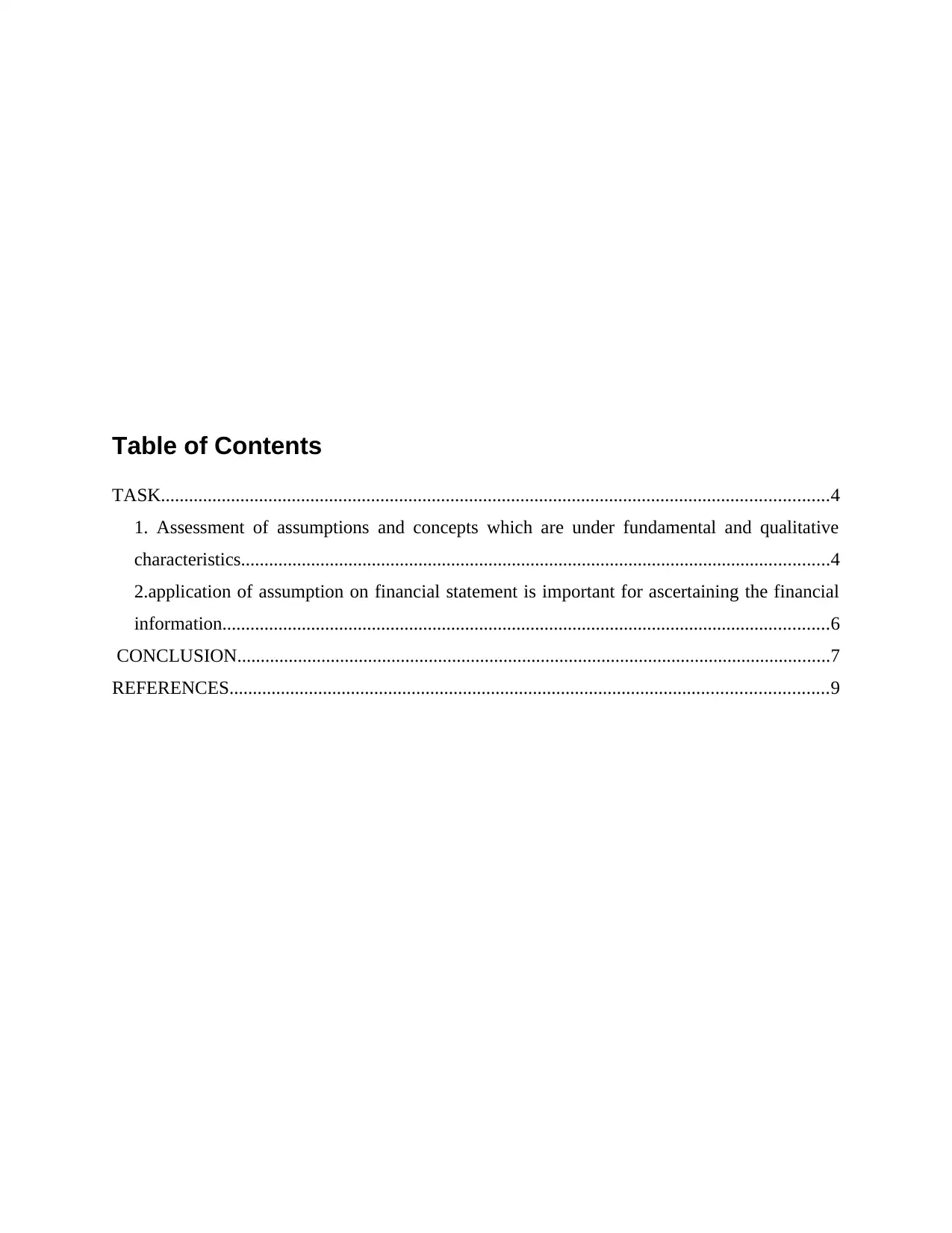
Table of Contents
TASK...............................................................................................................................................4
1. Assessment of assumptions and concepts which are under fundamental and qualitative
characteristics..............................................................................................................................4
2.application of assumption on financial statement is important for ascertaining the financial
information..................................................................................................................................6
CONCLUSION...............................................................................................................................7
REFERENCES................................................................................................................................9
TASK...............................................................................................................................................4
1. Assessment of assumptions and concepts which are under fundamental and qualitative
characteristics..............................................................................................................................4
2.application of assumption on financial statement is important for ascertaining the financial
information..................................................................................................................................6
CONCLUSION...............................................................................................................................7
REFERENCES................................................................................................................................9

⊘ This is a preview!⊘
Do you want full access?
Subscribe today to unlock all pages.

Trusted by 1+ million students worldwide
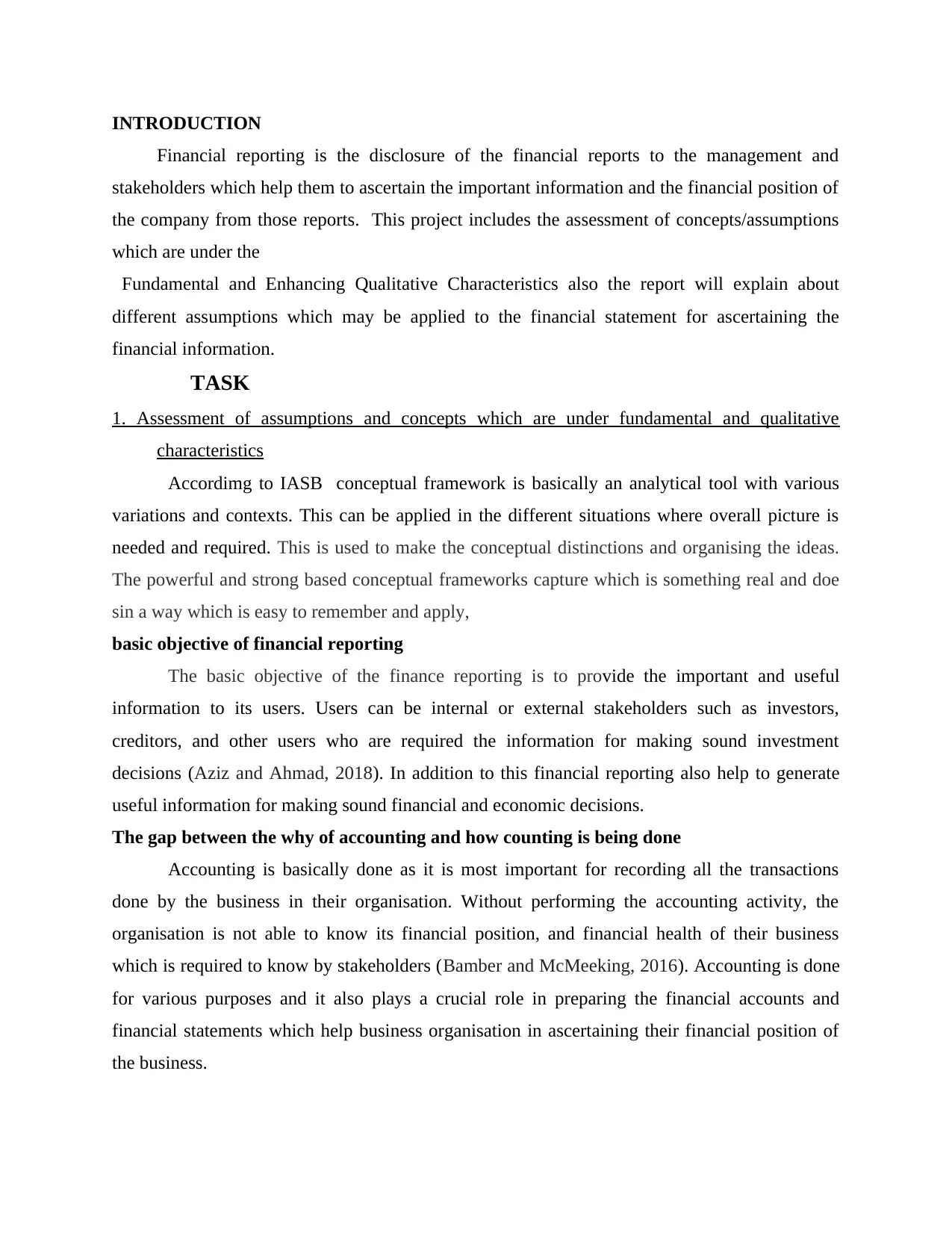
INTRODUCTION
Financial reporting is the disclosure of the financial reports to the management and
stakeholders which help them to ascertain the important information and the financial position of
the company from those reports. This project includes the assessment of concepts/assumptions
which are under the
Fundamental and Enhancing Qualitative Characteristics also the report will explain about
different assumptions which may be applied to the financial statement for ascertaining the
financial information.
TASK
1. Assessment of assumptions and concepts which are under fundamental and qualitative
characteristics
Accordimg to IASB conceptual framework is basically an analytical tool with various
variations and contexts. This can be applied in the different situations where overall picture is
needed and required. This is used to make the conceptual distinctions and organising the ideas.
The powerful and strong based conceptual frameworks capture which is something real and doe
sin a way which is easy to remember and apply,
basic objective of financial reporting
The basic objective of the finance reporting is to provide the important and useful
information to its users. Users can be internal or external stakeholders such as investors,
creditors, and other users who are required the information for making sound investment
decisions (Aziz and Ahmad, 2018). In addition to this financial reporting also help to generate
useful information for making sound financial and economic decisions.
The gap between the why of accounting and how counting is being done
Accounting is basically done as it is most important for recording all the transactions
done by the business in their organisation. Without performing the accounting activity, the
organisation is not able to know its financial position, and financial health of their business
which is required to know by stakeholders (Bamber and McMeeking, 2016). Accounting is done
for various purposes and it also plays a crucial role in preparing the financial accounts and
financial statements which help business organisation in ascertaining their financial position of
the business.
Financial reporting is the disclosure of the financial reports to the management and
stakeholders which help them to ascertain the important information and the financial position of
the company from those reports. This project includes the assessment of concepts/assumptions
which are under the
Fundamental and Enhancing Qualitative Characteristics also the report will explain about
different assumptions which may be applied to the financial statement for ascertaining the
financial information.
TASK
1. Assessment of assumptions and concepts which are under fundamental and qualitative
characteristics
Accordimg to IASB conceptual framework is basically an analytical tool with various
variations and contexts. This can be applied in the different situations where overall picture is
needed and required. This is used to make the conceptual distinctions and organising the ideas.
The powerful and strong based conceptual frameworks capture which is something real and doe
sin a way which is easy to remember and apply,
basic objective of financial reporting
The basic objective of the finance reporting is to provide the important and useful
information to its users. Users can be internal or external stakeholders such as investors,
creditors, and other users who are required the information for making sound investment
decisions (Aziz and Ahmad, 2018). In addition to this financial reporting also help to generate
useful information for making sound financial and economic decisions.
The gap between the why of accounting and how counting is being done
Accounting is basically done as it is most important for recording all the transactions
done by the business in their organisation. Without performing the accounting activity, the
organisation is not able to know its financial position, and financial health of their business
which is required to know by stakeholders (Bamber and McMeeking, 2016). Accounting is done
for various purposes and it also plays a crucial role in preparing the financial accounts and
financial statements which help business organisation in ascertaining their financial position of
the business.
Paraphrase This Document
Need a fresh take? Get an instant paraphrase of this document with our AI Paraphraser
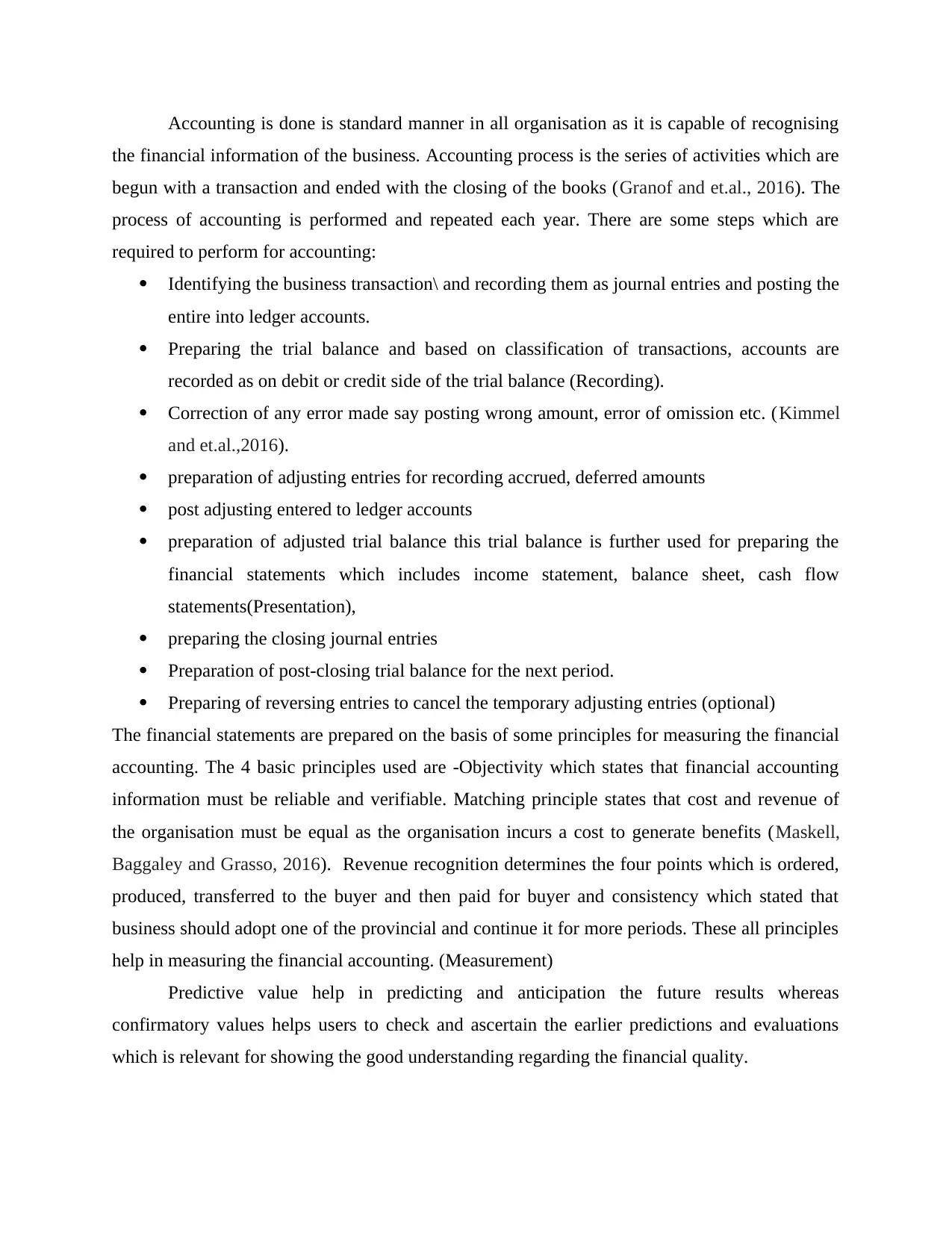
Accounting is done is standard manner in all organisation as it is capable of recognising
the financial information of the business. Accounting process is the series of activities which are
begun with a transaction and ended with the closing of the books (Granof and et.al., 2016). The
process of accounting is performed and repeated each year. There are some steps which are
required to perform for accounting:
Identifying the business transaction\ and recording them as journal entries and posting the
entire into ledger accounts.
Preparing the trial balance and based on classification of transactions, accounts are
recorded as on debit or credit side of the trial balance (Recording).
Correction of any error made say posting wrong amount, error of omission etc. (Kimmel
and et.al.,2016).
preparation of adjusting entries for recording accrued, deferred amounts
post adjusting entered to ledger accounts
preparation of adjusted trial balance this trial balance is further used for preparing the
financial statements which includes income statement, balance sheet, cash flow
statements(Presentation),
preparing the closing journal entries
Preparation of post-closing trial balance for the next period.
Preparing of reversing entries to cancel the temporary adjusting entries (optional)
The financial statements are prepared on the basis of some principles for measuring the financial
accounting. The 4 basic principles used are -Objectivity which states that financial accounting
information must be reliable and verifiable. Matching principle states that cost and revenue of
the organisation must be equal as the organisation incurs a cost to generate benefits (Maskell,
Baggaley and Grasso, 2016). Revenue recognition determines the four points which is ordered,
produced, transferred to the buyer and then paid for buyer and consistency which stated that
business should adopt one of the provincial and continue it for more periods. These all principles
help in measuring the financial accounting. (Measurement)
Predictive value help in predicting and anticipation the future results whereas
confirmatory values helps users to check and ascertain the earlier predictions and evaluations
which is relevant for showing the good understanding regarding the financial quality.
the financial information of the business. Accounting process is the series of activities which are
begun with a transaction and ended with the closing of the books (Granof and et.al., 2016). The
process of accounting is performed and repeated each year. There are some steps which are
required to perform for accounting:
Identifying the business transaction\ and recording them as journal entries and posting the
entire into ledger accounts.
Preparing the trial balance and based on classification of transactions, accounts are
recorded as on debit or credit side of the trial balance (Recording).
Correction of any error made say posting wrong amount, error of omission etc. (Kimmel
and et.al.,2016).
preparation of adjusting entries for recording accrued, deferred amounts
post adjusting entered to ledger accounts
preparation of adjusted trial balance this trial balance is further used for preparing the
financial statements which includes income statement, balance sheet, cash flow
statements(Presentation),
preparing the closing journal entries
Preparation of post-closing trial balance for the next period.
Preparing of reversing entries to cancel the temporary adjusting entries (optional)
The financial statements are prepared on the basis of some principles for measuring the financial
accounting. The 4 basic principles used are -Objectivity which states that financial accounting
information must be reliable and verifiable. Matching principle states that cost and revenue of
the organisation must be equal as the organisation incurs a cost to generate benefits (Maskell,
Baggaley and Grasso, 2016). Revenue recognition determines the four points which is ordered,
produced, transferred to the buyer and then paid for buyer and consistency which stated that
business should adopt one of the provincial and continue it for more periods. These all principles
help in measuring the financial accounting. (Measurement)
Predictive value help in predicting and anticipation the future results whereas
confirmatory values helps users to check and ascertain the earlier predictions and evaluations
which is relevant for showing the good understanding regarding the financial quality.
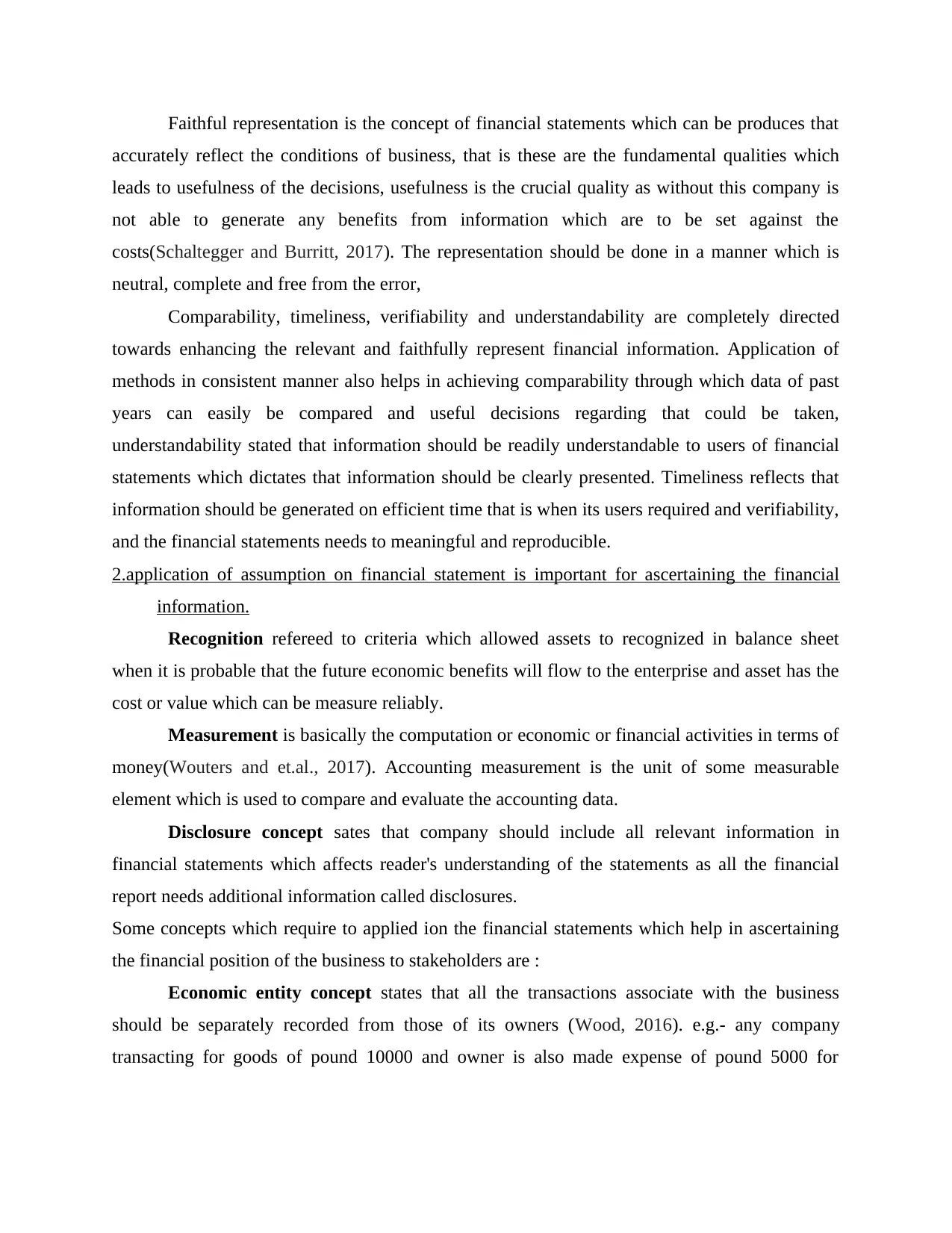
Faithful representation is the concept of financial statements which can be produces that
accurately reflect the conditions of business, that is these are the fundamental qualities which
leads to usefulness of the decisions, usefulness is the crucial quality as without this company is
not able to generate any benefits from information which are to be set against the
costs(Schaltegger and Burritt, 2017). The representation should be done in a manner which is
neutral, complete and free from the error,
Comparability, timeliness, verifiability and understandability are completely directed
towards enhancing the relevant and faithfully represent financial information. Application of
methods in consistent manner also helps in achieving comparability through which data of past
years can easily be compared and useful decisions regarding that could be taken,
understandability stated that information should be readily understandable to users of financial
statements which dictates that information should be clearly presented. Timeliness reflects that
information should be generated on efficient time that is when its users required and verifiability,
and the financial statements needs to meaningful and reproducible.
2.application of assumption on financial statement is important for ascertaining the financial
information.
Recognition refereed to criteria which allowed assets to recognized in balance sheet
when it is probable that the future economic benefits will flow to the enterprise and asset has the
cost or value which can be measure reliably.
Measurement is basically the computation or economic or financial activities in terms of
money(Wouters and et.al., 2017). Accounting measurement is the unit of some measurable
element which is used to compare and evaluate the accounting data.
Disclosure concept sates that company should include all relevant information in
financial statements which affects reader's understanding of the statements as all the financial
report needs additional information called disclosures.
Some concepts which require to applied ion the financial statements which help in ascertaining
the financial position of the business to stakeholders are :
Economic entity concept states that all the transactions associate with the business
should be separately recorded from those of its owners (Wood, 2016). e.g.- any company
transacting for goods of pound 10000 and owner is also made expense of pound 5000 for
accurately reflect the conditions of business, that is these are the fundamental qualities which
leads to usefulness of the decisions, usefulness is the crucial quality as without this company is
not able to generate any benefits from information which are to be set against the
costs(Schaltegger and Burritt, 2017). The representation should be done in a manner which is
neutral, complete and free from the error,
Comparability, timeliness, verifiability and understandability are completely directed
towards enhancing the relevant and faithfully represent financial information. Application of
methods in consistent manner also helps in achieving comparability through which data of past
years can easily be compared and useful decisions regarding that could be taken,
understandability stated that information should be readily understandable to users of financial
statements which dictates that information should be clearly presented. Timeliness reflects that
information should be generated on efficient time that is when its users required and verifiability,
and the financial statements needs to meaningful and reproducible.
2.application of assumption on financial statement is important for ascertaining the financial
information.
Recognition refereed to criteria which allowed assets to recognized in balance sheet
when it is probable that the future economic benefits will flow to the enterprise and asset has the
cost or value which can be measure reliably.
Measurement is basically the computation or economic or financial activities in terms of
money(Wouters and et.al., 2017). Accounting measurement is the unit of some measurable
element which is used to compare and evaluate the accounting data.
Disclosure concept sates that company should include all relevant information in
financial statements which affects reader's understanding of the statements as all the financial
report needs additional information called disclosures.
Some concepts which require to applied ion the financial statements which help in ascertaining
the financial position of the business to stakeholders are :
Economic entity concept states that all the transactions associate with the business
should be separately recorded from those of its owners (Wood, 2016). e.g.- any company
transacting for goods of pound 10000 and owner is also made expense of pound 5000 for
⊘ This is a preview!⊘
Do you want full access?
Subscribe today to unlock all pages.

Trusted by 1+ million students worldwide
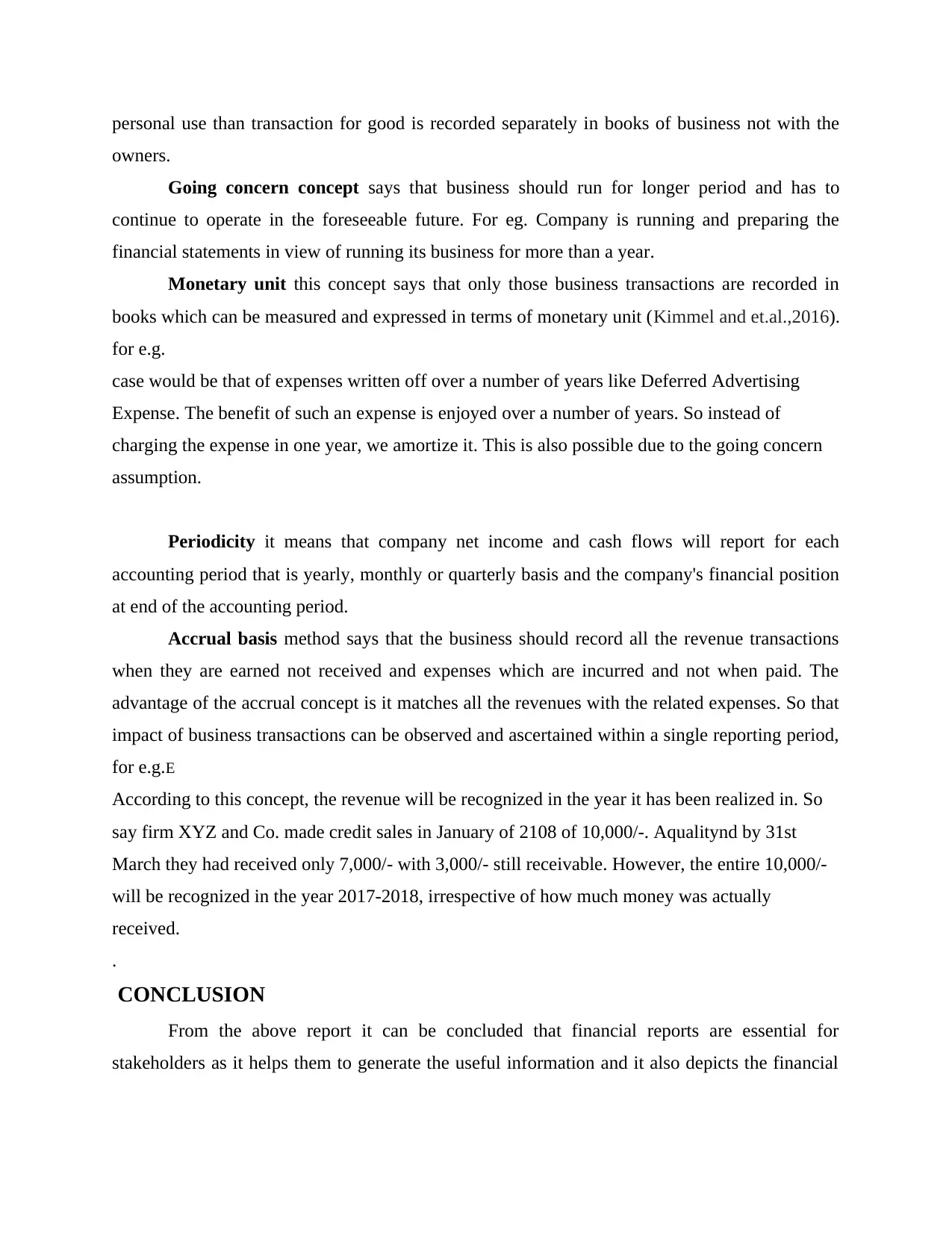
personal use than transaction for good is recorded separately in books of business not with the
owners.
Going concern concept says that business should run for longer period and has to
continue to operate in the foreseeable future. For eg. Company is running and preparing the
financial statements in view of running its business for more than a year.
Monetary unit this concept says that only those business transactions are recorded in
books which can be measured and expressed in terms of monetary unit (Kimmel and et.al.,2016).
for e.g.
case would be that of expenses written off over a number of years like Deferred Advertising
Expense. The benefit of such an expense is enjoyed over a number of years. So instead of
charging the expense in one year, we amortize it. This is also possible due to the going concern
assumption.
Periodicity it means that company net income and cash flows will report for each
accounting period that is yearly, monthly or quarterly basis and the company's financial position
at end of the accounting period.
Accrual basis method says that the business should record all the revenue transactions
when they are earned not received and expenses which are incurred and not when paid. The
advantage of the accrual concept is it matches all the revenues with the related expenses. So that
impact of business transactions can be observed and ascertained within a single reporting period,
for e.g.E
According to this concept, the revenue will be recognized in the year it has been realized in. So
say firm XYZ and Co. made credit sales in January of 2108 of 10,000/-. Aqualitynd by 31st
March they had received only 7,000/- with 3,000/- still receivable. However, the entire 10,000/-
will be recognized in the year 2017-2018, irrespective of how much money was actually
received.
.
CONCLUSION
From the above report it can be concluded that financial reports are essential for
stakeholders as it helps them to generate the useful information and it also depicts the financial
owners.
Going concern concept says that business should run for longer period and has to
continue to operate in the foreseeable future. For eg. Company is running and preparing the
financial statements in view of running its business for more than a year.
Monetary unit this concept says that only those business transactions are recorded in
books which can be measured and expressed in terms of monetary unit (Kimmel and et.al.,2016).
for e.g.
case would be that of expenses written off over a number of years like Deferred Advertising
Expense. The benefit of such an expense is enjoyed over a number of years. So instead of
charging the expense in one year, we amortize it. This is also possible due to the going concern
assumption.
Periodicity it means that company net income and cash flows will report for each
accounting period that is yearly, monthly or quarterly basis and the company's financial position
at end of the accounting period.
Accrual basis method says that the business should record all the revenue transactions
when they are earned not received and expenses which are incurred and not when paid. The
advantage of the accrual concept is it matches all the revenues with the related expenses. So that
impact of business transactions can be observed and ascertained within a single reporting period,
for e.g.E
According to this concept, the revenue will be recognized in the year it has been realized in. So
say firm XYZ and Co. made credit sales in January of 2108 of 10,000/-. Aqualitynd by 31st
March they had received only 7,000/- with 3,000/- still receivable. However, the entire 10,000/-
will be recognized in the year 2017-2018, irrespective of how much money was actually
received.
.
CONCLUSION
From the above report it can be concluded that financial reports are essential for
stakeholders as it helps them to generate the useful information and it also depicts the financial
Paraphrase This Document
Need a fresh take? Get an instant paraphrase of this document with our AI Paraphraser

position of the business. The different assumption can be applied on financial statements for
more reliability.
more reliability.
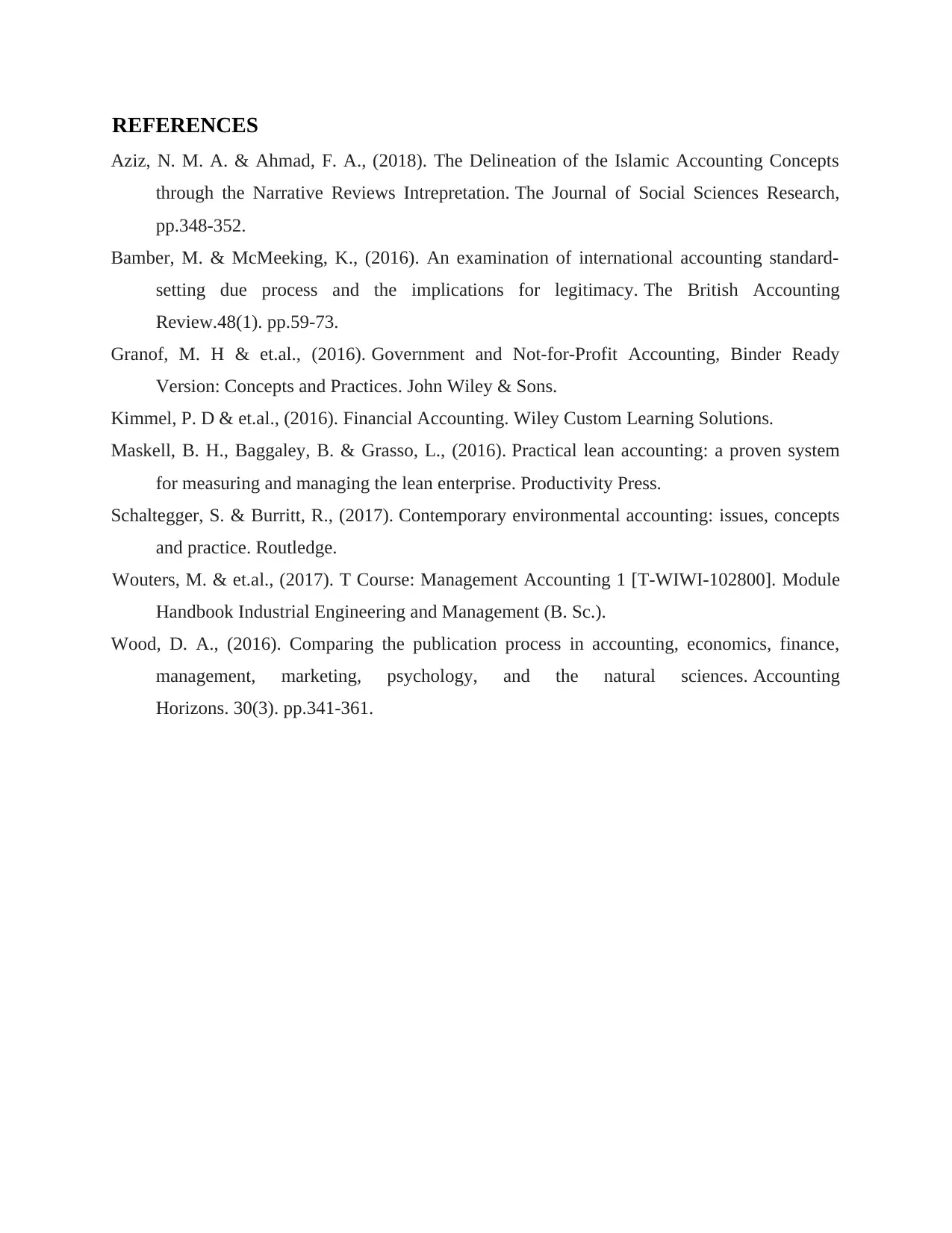
REFERENCES
Aziz, N. M. A. & Ahmad, F. A., (2018). The Delineation of the Islamic Accounting Concepts
through the Narrative Reviews Intrepretation. The Journal of Social Sciences Research,
pp.348-352.
Bamber, M. & McMeeking, K., (2016). An examination of international accounting standard-
setting due process and the implications for legitimacy. The British Accounting
Review.48(1). pp.59-73.
Granof, M. H & et.al., (2016). Government and Not-for-Profit Accounting, Binder Ready
Version: Concepts and Practices. John Wiley & Sons.
Kimmel, P. D & et.al., (2016). Financial Accounting. Wiley Custom Learning Solutions.
Maskell, B. H., Baggaley, B. & Grasso, L., (2016). Practical lean accounting: a proven system
for measuring and managing the lean enterprise. Productivity Press.
Schaltegger, S. & Burritt, R., (2017). Contemporary environmental accounting: issues, concepts
and practice. Routledge.
Wouters, M. & et.al., (2017). T Course: Management Accounting 1 [T-WIWI-102800]. Module
Handbook Industrial Engineering and Management (B. Sc.).
Wood, D. A., (2016). Comparing the publication process in accounting, economics, finance,
management, marketing, psychology, and the natural sciences. Accounting
Horizons. 30(3). pp.341-361.
Aziz, N. M. A. & Ahmad, F. A., (2018). The Delineation of the Islamic Accounting Concepts
through the Narrative Reviews Intrepretation. The Journal of Social Sciences Research,
pp.348-352.
Bamber, M. & McMeeking, K., (2016). An examination of international accounting standard-
setting due process and the implications for legitimacy. The British Accounting
Review.48(1). pp.59-73.
Granof, M. H & et.al., (2016). Government and Not-for-Profit Accounting, Binder Ready
Version: Concepts and Practices. John Wiley & Sons.
Kimmel, P. D & et.al., (2016). Financial Accounting. Wiley Custom Learning Solutions.
Maskell, B. H., Baggaley, B. & Grasso, L., (2016). Practical lean accounting: a proven system
for measuring and managing the lean enterprise. Productivity Press.
Schaltegger, S. & Burritt, R., (2017). Contemporary environmental accounting: issues, concepts
and practice. Routledge.
Wouters, M. & et.al., (2017). T Course: Management Accounting 1 [T-WIWI-102800]. Module
Handbook Industrial Engineering and Management (B. Sc.).
Wood, D. A., (2016). Comparing the publication process in accounting, economics, finance,
management, marketing, psychology, and the natural sciences. Accounting
Horizons. 30(3). pp.341-361.
⊘ This is a preview!⊘
Do you want full access?
Subscribe today to unlock all pages.

Trusted by 1+ million students worldwide
1 out of 9
Related Documents
Your All-in-One AI-Powered Toolkit for Academic Success.
+13062052269
info@desklib.com
Available 24*7 on WhatsApp / Email
![[object Object]](/_next/static/media/star-bottom.7253800d.svg)
Unlock your academic potential
Copyright © 2020–2025 A2Z Services. All Rights Reserved. Developed and managed by ZUCOL.





